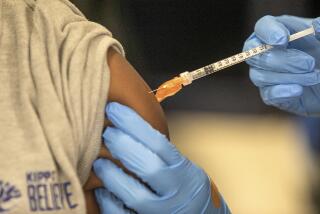Childhood Heart Ailment Linked to 2 Bacteria
- Share via
Kawasaki syndrome, the most common cause of non-inherited heart disease in children and a particular problem among those of Japanese and Korean descent, is caused by at least two previously unknown bacteria that secrete a poison, researchers reported today.
The finding, if it can be verified by other researchers, should make it much easier to diagnose the syndrome and begin treatment at an early, highly curable stage. If untreated or caught late, the disease causes aneurysms in the blood vessels supplying the heart, which can lead to fatal heart attacks.
Further work could also make it possible to develop a vaccine against Kawasaki syndrome.
The cause of this baffling disease, which strikes an estimated 5,000 children in the United States each year--especially in areas such as Los Angeles with a large Asian population--has been a mystery to researchers since it was identified in Japan 25 years ago.
The two bacteria tentatively linked to it, the researchers report in the medical journal Lancet, have probably been overlooked because they appear harmless.
The discovery “is a major step forward in providing insight into this acute illness of early childhood,” said Dr. H. Cody Meissner of the New England Medical Center in Boston, a co-author of the paper.
The study “is impeccable in terms of their laboratory work,” said Dr. Masato Takahashi of Childrens Hospital Los Angeles, where about a third of the Kawasaki patients in this area are treated.
Dr. William Mason of Childrens cautioned that “there have been a number of proposed causes of Kawasaki syndrome through the years and each met with a lot of excitement. And each time, unfortunately, there has been disappointment when others failed to confirm the initial observation. This needs to be confirmed.”
The co-discoverer of the bacteria, Dr. Donald Y.M. Leung of the National Jewish Center for Immunology and Respiratory Medicine in Denver, agreed that others need to replicate their results. “But we feel that . . . this is the most likely cause of the disease,” he said.
A consortium of researchers in Los Angeles, Honolulu, Denver, Chicago and Boston has been organized to try to confirm the discovery.
The syndrome was first described in 1967 by Dr. Tomisaku Kawasaki, a pediatrician in Tokyo. More than 120,000 cases have been documented there.
The first case in the United States was confirmed in Hawaii in 1971. That state apparently has the highest incidence of Kawasaki syndrome in the United States, but researchers are unsure of the precise number because the syndrome does not have to be reported to public health authorities.
The syndrome most often strikes children between the ages of 6 months and 8 years. It begins with a high fever, usually accompanied by a skin rash that can look like measles or scarlet fever.
Patients’ eyes get red and their lips become red, swollen and cracked. The tongue gets swollen and cracked so that it looks like a strawberry. The lymph nodes in the neck swell and the hands and feet also become red and swollen.
But the most insidious problem does not develop until after the acute symptoms have disappeared. As a result of an intense immune response, the walls of the coronary arteries, which supply oxygen and nourishment to the heart, become stretched and weakened, forming aneurysms that can fatally burst under stress. About one-quarter of untreated Kawasaki patients develop aneurysms, and 2% of the patients used to die. In others, severe arthritis may occur.
The death rate has declined sharply because physicians have developed an effective treatment--high doses of aspirin and infusions of gamma globulin, a concentrated mix of antibodies isolated from human blood.
Diagnosis of the syndrome can be difficult, Leung said, because the symptoms are similar to those of other diseases. Physicians usually diagnose it if a patient has five of the six major symptoms. Some children have only three or four symptoms, he said, and the disease is not diagnosed until the cardiac problems develop later.
Physicians do not want to use the treatment on children who do not have the syndrome because it is expensive--as much as $3,000 for the gamma globulin alone--and some children are allergic to it.
If the syndrome is caused by the bacteria, researchers agreed, it should be possible to quickly develop a lab test, allowing a definitive diagnosis to be made at an early stage before any permanent harm has been done.




